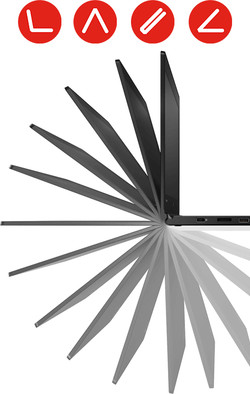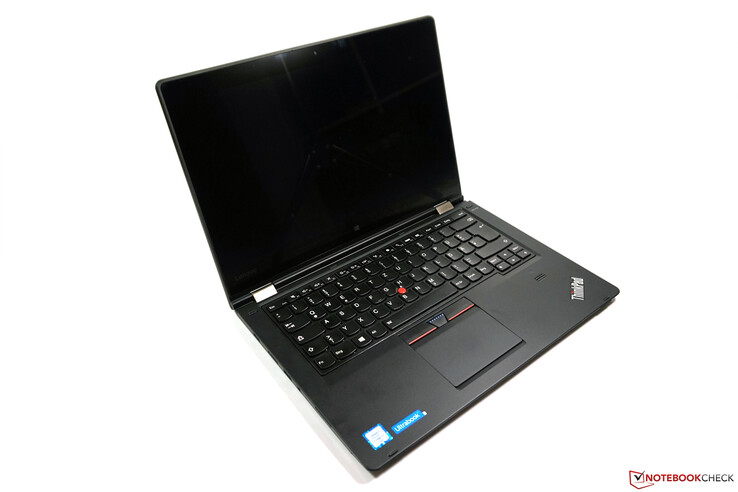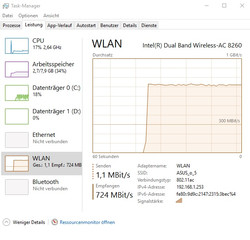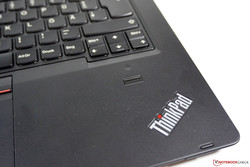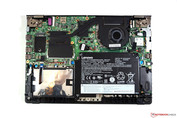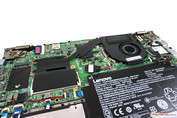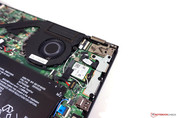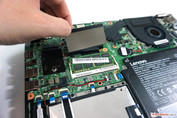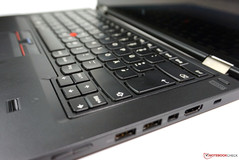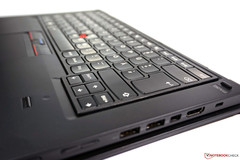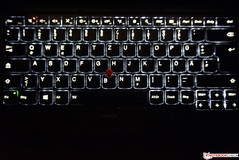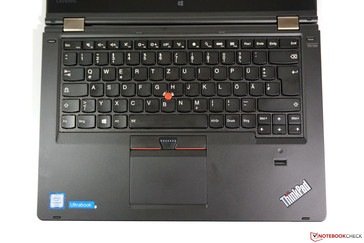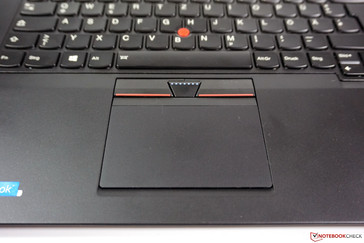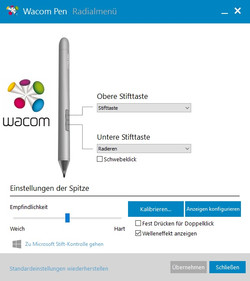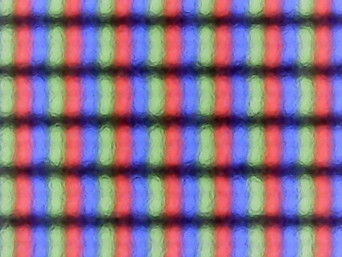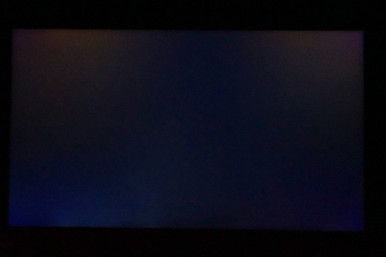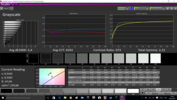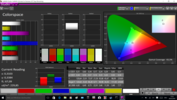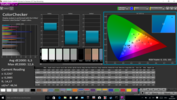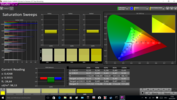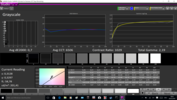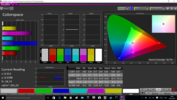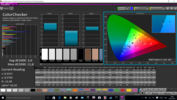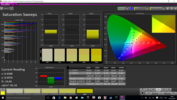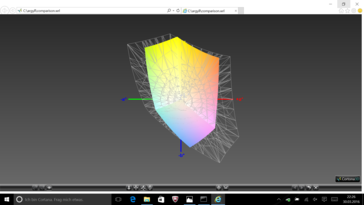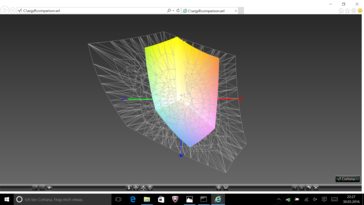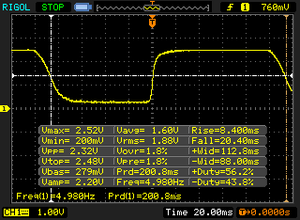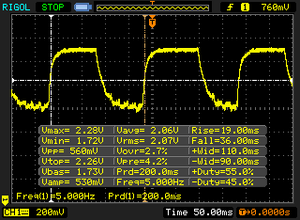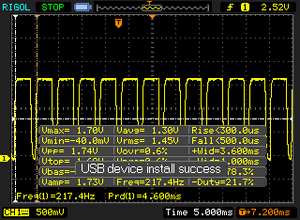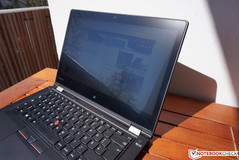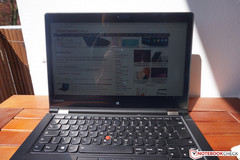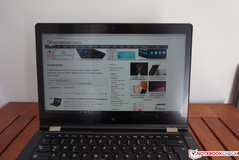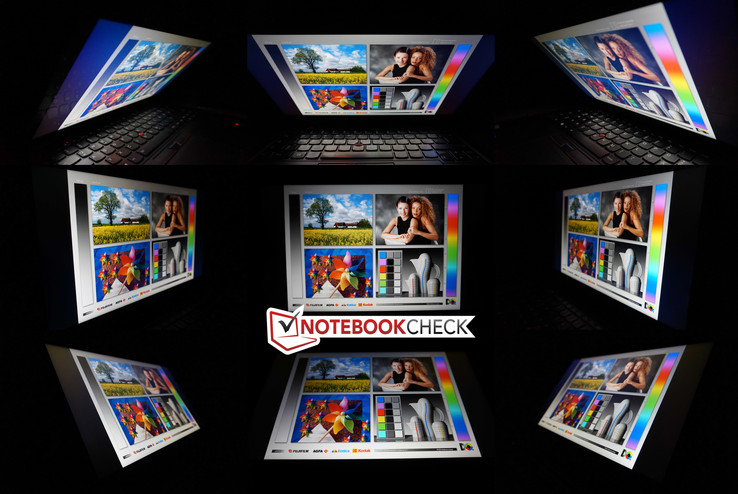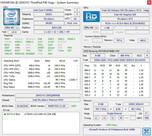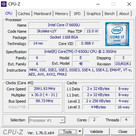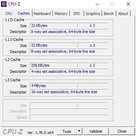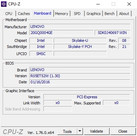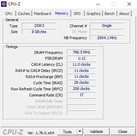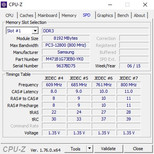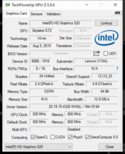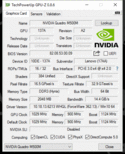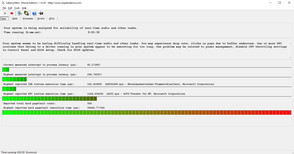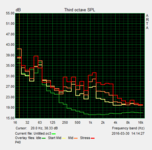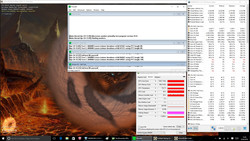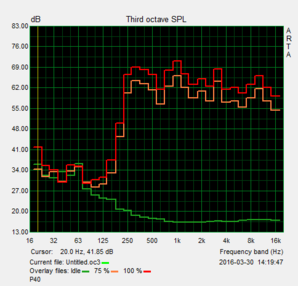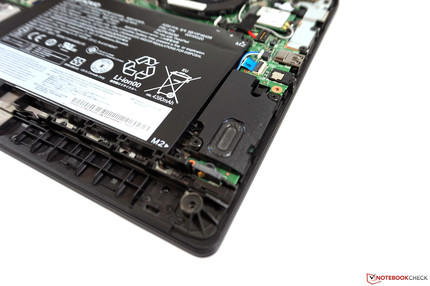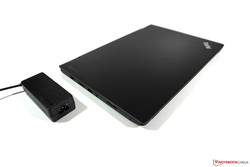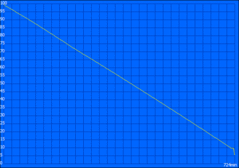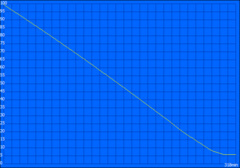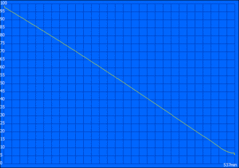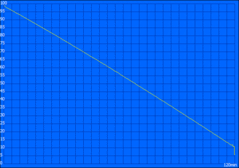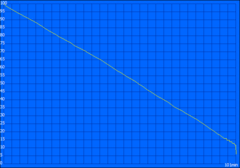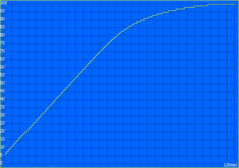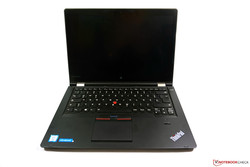Lenovo ThinkPad P40 Yoga Workstation Review

For the original German review, see here.
Lenovo offers devices with the addition Yoga in pretty much every size and shape, and they are very versatile with their 360-degree hinges. Now we also get such a Yoga device in Lenovo’s new workstation lineup, more precisely the ThinkPad P40 Yoga. It is based on the "normal" ThinkPad Yoga 460 and the two devices are actually almost identical. Our workstation model is equipped with an additional Quadro GPU from Nvidia including ISV certifications. Our test unit has the designation 20GQ-0004GE and retails for around 1,900 Euros, ~$2180 (EDU model: 1,500 Euros, ~$1721), which means you pay a hefty premium of 500 Euros (~$573) compared to the (except for the dGPU) otherwise similarly equipped ThinkPad Yoga 460. By the way, both devices are shipped with the digitizer ThinkPad Pen Pro, which is based on Wacom technology. More on that later.
Besides the previously mentioned Quadro GPU from Nvidia, our review unit is equipped with an i7 dual-core processor from Intel, 8 GB RAM as well as a 256 GB SSD. Noticeable are the old standards, because users neither get a modern and space-saving M.2-2280 slot nor DDR4 memory. This reminds us of the bigger ThinkPad P50s we reviewed with the identical CPU/GPU combination.
Because of the very specialized orientation, there are actually no direct rivals for the ThinkPad P40 Yoga. We did review a couple of 2-in-1 devices with dedicated graphics cards, but it is the first device with a workstation GPU. One interesting alternative is certainly the Microsoft Surface Book, which can also keep up in terms of performance. We will also consider the previously mentioned ThinkPad Yoga 460 and the new ThinkPad X1 Yoga. The latter does waive a dedicated GPU but has a much thinner and lighter chassis in return.
Case
The chassis of the P40 Yoga is immediately recognizable as a ThinkPad: black surfaces, metal hinges and a red dot in the center of the keyboard. The design is certainly a matter of taste, but the device fits very well into a productive environment. The case is made of a carbon-fiber magnesium alloy, which is supposed to ensure high stability. Similar to the ThinkPad Yoga 14, however, we can find some problems in this respect we did not expect at this price point. The lid is comparatively thick, but even light pressure or twisting attempts will immediately cause ripples on the screen and we can also hear creaking. The situation is a bit better for the base unit, but there is creaking as well. You can also slightly dent the keyboard area and the function keys in particular are very clattery. This is probably a result of the Lift’n’Lock feature of the keyboard (frame is lifted), but it does affect the quality impression.
Similar to all Yoga models, the P40 Yoga obviously offers the four different operating modes (notebook, tent, stand, tablet), although the two modes tent and stand are mainly designed to consume media. This is also supported by the weak hinges, which bounce quite a lot during touch inputs. Over the course of the review, we therefore usually used the P40 Yoga as a notebook or a tablet. However, you should not underestimate the high weight of almost 1.9 kg when you use it as a tablet, which will be inconvenient after a short while.
But not everything is bad. The black surfaces are slightly roughened and there are no problems with fingerprints. The digitizer can be stored inside the chassis and is also charged at the same time. There is no maintenance hatch, but you can remove the whole bottom cover. More on that later.
Connectivity
The port variety of the ThinkPad P40 Yoga is decent, but you will have to waive modern ports like USB-C or Thunderbolt 3. Annoying for business customers: Lenovo also waives a SmartCard reader. Docking stations can be attached via proprietary OneLink+ port. The maximum resolution of the HDMI port is Full HD (1920x1080 pixels, 60 Hz) according to the spec sheet, while the Mini-DisplayPort can also drive 4K displays at 60 Hz. You have to use an adapter for wired networks. The ports on the right side in particular are pretty crowded, so there can actually be problems with wider cables or USB flash drives.
The performance of the USB ports is very good. We can determine up to 426 MB/s (read) and 420 MB/s (write), respectively, in combination with our external Samsung SSD T1, which is almost the limit of this hard drive. The SD-card reader also performs very well. We managed up to 172 MB/s (read) and 151 MB/s (write) with our reference card Toshiba Exceria Pro UHS-II (up to 260 MB/s). Pictures (around 5 MB each) are transferred at around 120 MB/s.
Communication
Let’s start with the bad news. The ThinkPad P40 Yoga basically supports WWAN modules and the necessary M.2 slot (2242) is available as well, but not all models are WWAN-ready. This is also the case for our review unit, because the necessary antennas are not integrated and there is no SIM-slot, either. You should therefore make sure your desired configuration is WWAN-ready or is shipped with an integrated LTE module.
Similar to many other modern notebooks, wireless network connections are handled by the Wi-Fi module Dual-Band 8260 from Intel. It supports Bluetooth 4.2 as well as the fast 802.11 ac standard and works with 2.4 and 5 GHz networks. The maximum transfer rate is 867 Mbps, and we can measure around 83 MB/s (802.11n: 12 MB/s) under perfect conditions (1 meter to the router Asus RT-AC56U) – very good results.
Lenovo also implements an HD webcam (720p), and the best description for the results is functional. Sharpness and colors are not very convenient, but you can clearly recognize the other person. Our impression of the dual-array microphone is much better. Voice recordings are very clear, so an external headset is not usually necessary.
Security
The only thing we miss is the SmartCard reader, but the security features of the ThinkPad P40 Yoga are otherwise comprehensive. At the right side of the palm rest is the fingerprint scanner, where you have to swipe your finger across the scanner. This is reliable, but the new touch models are faster and more comfortable. You can set up multiple passwords (hard drive, BIOS, power on) and the manufacturer also included a TPM module (TCG 1.2). Our hard drive is self-encrypting (OPAL 2 standards), but our test model does not support Intel’s vPro technology. A slot for a Kensington lock is obviously available as well.
Accessories
The docking stations are important accessories, which can either be attached via OneLink+ port or USB 3.0. Lenovo offers different models with prices between 110 and 180 Euros (~$126 and ~$206). Also interesting are the two adapters: Mini-DisplayPort to VGA and OneLink+ to VGA+RJ45. Both retail for around 30 Euros (~$34) each.
Maintenance
The bottom cover of the ThinkPad P40 Yoga is secured by multiple Philips screws, and three of them are located under rubber covers. The removal process is a bit tricky due to plastic clips, but it works pretty well if you are careful. After that you gain access to all important components, although both the CPU and the GPU are – as expected – soldered. A bit disappointing is the fact that we only get one memory slot, which is filled by an 8 GB module (DDR3) in our case. Upgrades are therefore unnecessary complicated, and the maximum amount of RAM is also limited to 16 GB. The free M.2 slot (2242) of our test model cannot be used for WWAN modules because the necessary antennas are not included.
Warranty
We are surprised by the warranty. Instead of a three-year On-Site service, which is usually common for ThinkPads, the device is only sold with a 1-year Bring-In service here in Germany. It can be extended and upgraded. A three-year On-Site service, for example, retails for around 190 Euros (~$218).
Input Devices
Keyboard
Lenovo implements the usual 6-row chiclet keyboard with spill-water protection. There is one special feature for the Yoga models though, because the frame is lifted when the display is opened by more than 180 degrees, so you get a solid surface. The keys are also locked and cannot be pressed anymore. Lenovo calls this feature Lift’n’Lock and it is basically a good idea, but the stability is slightly affected in the upper keyboard area (function and number keys) and the keys clatter a bit. This is unfortunate, because otherwise, we get a good keyboard with sufficient travel and good feedback. A two-stage white illumination is also implemented.
Touchpad & TrackPoint
You can move the cursor via ClickPad and TrackPoint with dedicated buttons. Both methods work reliably and do not cause any criticism, but the buttons of the TrackPoint could be quieter. Contrary to the bigger siblings from the P-series, Lenovo does not implement dedicated buttons for the touchpad, which is provided by Elan. Multi-touch gestures with up to three fingers are recognized and executed very well.
Touchscreen & Digitizer
The ThinkPad P40 Yoga is shipped with the active digitizer ThinkPad Pen Pro by default. It is based on Wacom technology and can be stored inside the chassis, where it is also charged. We had a closer look at the technology in our review of the ThinkPad X1 Yoga, so we want to refer to this article for more information.
Our impressions are very similar to the review of the X1 Yoga. The pen is very precise and the palm rejection in particular worked perfectly. The digitizer is, however, too thin to be handled comfortably and we experienced cramping issues after a while. The touchscreen itself is very precise and the handling was no problem. It does not have to hide behind high-quality tablets.
Display
There are two different IPS touchscreens for the ThinkPad P40 Yoga, either with the Full HD or the WQHD resolution. Our review unit is equipped with the FHD screen with 1920x1080 pixels, which results in a decent pixel density of 157 PPI in combination with the 14-inch screen. Tthe clearly visible backlight bleeding at the upper and lower frame is annoying.
The panel meets the specifications from the manufacturer or can surpass it according to our measurements. The maximum luminance is 256 cd/m² and the low black value (0.24 cd/m²) results in a very good contrast ratio of 954:1. We would have liked to see a brighter panel, especially in combination with the glossy surface, because reflections can even be a problem in bright indoor environments.
An indicator for the optional WQHD panel is the recently reviewed ThinkPad X1 Yoga. It is slightly brighter, but the contrast is lower due to the higher black value. The other devices within our comparison group perform better than the review unit.
| |||||||||||||||||||||||||
Brightness Distribution: 89 %
Center on Battery: 227 cd/m²
Contrast: 954:1 (Black: 0.24 cd/m²)
ΔE Color 6.3 | 0.5-29.43 Ø5
ΔE Greyscale 5.4 | 0.57-98 Ø5.3
65.5% sRGB (Calman 2D)
62% sRGB (Argyll 1.6.3 3D)
39.4% AdobeRGB 1998 (Argyll 1.6.3 3D)
43.2% AdobeRGB 1998 (Argyll 2.2.0 3D)
62.7% sRGB (Argyll 2.2.0 3D)
41.82% Display P3 (Argyll 2.2.0 3D)
Gamma: 2.22
| Lenovo ThinkPad P40 Yoga 20GQ-0004GE Quadro M500M, 6500U, Liteonit LCH-256V2S | Lenovo Thinkpad X1 Yoga 20FQ-000QUS HD Graphics 520, 6500U, Samsung SSD PM871 MZNLN512HCJH | Lenovo ThinkPad Yoga 14 GeForce 840M, 5500U, Samsung SSD PM851 512 GB MZ7TE512HMHP | Microsoft Surface Book Core i7 Maxwell GPU (940M, GDDR5), 6600U, Samsung MZFLV512 NVMe | Lenovo ThinkPad P50s-20FKS00400 Quadro M500M, 6500U, Samsung PM871 MZYLN256HCHP | |
|---|---|---|---|---|---|
| Display | 60% | 56% | 47% | ||
| Display P3 Coverage | 41.82 | 68.1 63% | 66.3 59% | 63.7 52% | |
| sRGB Coverage | 62.7 | 97.2 55% | 96 53% | 87.6 40% | |
| AdobeRGB 1998 Coverage | 43.2 | 70.2 63% | 68 57% | 63.8 48% | |
| Response Times | 9% | 6% | 11% | ||
| Response Time Grey 50% / Grey 80% * | 55 ? | 38 ? 31% | 39 ? 29% | 38 ? 31% | |
| Response Time Black / White * | 28.8 ? | 30.4 ? -6% | 34 ? -18% | 28.8 ? -0% | |
| PWM Frequency | 217 ? | 219 ? 1% | 219 ? 1% | ||
| Screen | 8% | 2% | 53% | 17% | |
| Brightness middle | 229 | 284.7 24% | 286 25% | 438 91% | 319 39% |
| Brightness | 241 | 272 13% | 274 14% | 414 72% | 290 20% |
| Brightness Distribution | 89 | 89 0% | 90 1% | 88 -1% | 82 -8% |
| Black Level * | 0.24 | 0.383 -60% | 0.3 -25% | 0.25 -4% | 0.31 -29% |
| Contrast | 954 | 743 -22% | 953 0% | 1752 84% | 1029 8% |
| Colorchecker dE 2000 * | 6.3 | 5.24 17% | 5.62 11% | 2.06 67% | 4.8 24% |
| Colorchecker dE 2000 max. * | 12.6 | 11.22 11% | 7.8 38% | ||
| Greyscale dE 2000 * | 5.4 | 7.32 -36% | 6.19 -15% | 2.87 47% | 5.7 -6% |
| Gamma | 2.22 99% | 2.22 99% | 2.35 94% | 2.44 90% | 2.07 106% |
| CCT | 6592 99% | 6277 104% | 5606 116% | 6820 95% | 6260 104% |
| Color Space (Percent of AdobeRGB 1998) | 39.4 | 70.17 78% | 64 62% | 56.9 44% | |
| Color Space (Percent of sRGB) | 62 | 94.68 53% | 96 55% | 87.4 41% | |
| Total Average (Program / Settings) | 26% /
18% | 2% /
2% | 38% /
47% | 25% /
21% |
* ... smaller is better
We are not convinced by the color accuracy of the IPS panel ex-works. We use a spectrophotometer and the professional software CalMAN for our measurements. The average DeltaE-2000 deviations compared to the sRGB reference are 5.4 for the grayscale and 6.3 for the colors, but there are some extreme outliers for the blue tones. We also noticed a slight blue cast. A calibration improves the situation: The outliers are still visible, but the average deviation drops to 3.9 (ideal < 3). The grayscale benefits the most, where the average deviation drops to an excellent 0.7. The blue cast is also gone and both the color temperature and the gamma value are close to their respective ideal values. The color-space coverage is not as good, because only 62% sRGB and 39% AdobeRGB are not sufficient for professional users. The calibrated WQHD panel of the ThinkPad X1 Yoga performs much better in this respect.
Display Response Times
| ↔ Response Time Black to White | ||
|---|---|---|
| 28.8 ms ... rise ↗ and fall ↘ combined | ↗ 8.4 ms rise | |
| ↘ 20.4 ms fall | ||
| The screen shows relatively slow response rates in our tests and may be too slow for gamers. In comparison, all tested devices range from 0.1 (minimum) to 240 (maximum) ms. » 72 % of all devices are better. This means that the measured response time is worse than the average of all tested devices (21.5 ms). | ||
| ↔ Response Time 50% Grey to 80% Grey | ||
| 55 ms ... rise ↗ and fall ↘ combined | ↗ 19 ms rise | |
| ↘ 36 ms fall | ||
| The screen shows slow response rates in our tests and will be unsatisfactory for gamers. In comparison, all tested devices range from 0.2 (minimum) to 636 (maximum) ms. » 90 % of all devices are better. This means that the measured response time is worse than the average of all tested devices (33.7 ms). | ||
Screen Flickering / PWM (Pulse-Width Modulation)
| Screen flickering / PWM detected | 217 Hz | ≤ 40 % brightness setting | |
The display backlight flickers at 217 Hz (worst case, e.g., utilizing PWM) Flickering detected at a brightness setting of 40 % and below. There should be no flickering or PWM above this brightness setting. The frequency of 217 Hz is relatively low, so sensitive users will likely notice flickering and experience eyestrain at the stated brightness setting and below. In comparison: 53 % of all tested devices do not use PWM to dim the display. If PWM was detected, an average of 17903 (minimum: 5 - maximum: 3846000) Hz was measured. | |||
The display brightness is not reduced on battery power, but the ThinkPad P40 Yoga does not leave a good impression outdoors due to the glossy surface. The background illumination is just not powerful enough to overcome reflections, so it can also be tricky in the shade. It is hardly possible to work under direct sunlight.
Performance
Compared to other business devices, the available components for the ThinkPad P40 Yoga are rather limited. You can choose between two different Core i7 ULV chips, but otherwise you can only influence the memory equipment. All models are equipped with the Quadro M500M from Nvidia. Similar to the ThinkPad P50s, Lenovo uses 2.5-inch hard drives as well as DDR3L-RAM. However, we are dealing with a more compact chassis here, so the manufacturer wastes important space. We would have liked to see an M.2-2280 slot and an additional memory slot. The maximum amount of memory is limited to 16 GB in a single-channel configuration.
Processor
We already reviewed the modern ULV dual-cores from Intel a couple of times, so we will only give you the most important specs at this point. The Core i7-6500U (Skylake, 2.5-3.1 GHz) can execute four threads simultaneously and is powerful enough for many scenarios but does not support vPro. The processor of the ThinkPad P40 Yoga can consume more power for a short while, but the usual TDP limit at 15 Watts will set in after around 30 seconds and the Turbo Boost will drop from 3.0 GHz (for two active cores) to around 2.8-2.9 GHz.
The processors of the comparison devices are very close in the benchmarks. Almost all devices use i7 processors from the Skylake generation, so the differences are usually in the single-digit range. The optional i7-6600U does not make much sense when you look at the performance, but it does support Intel’s vPro technology. More benchmarks with the Core i7-6500U are available in our Tech section.
System Performance
Thanks to the fast processor and the Solid State Drive, the subjective performance impression of the ThinkPad P40 Yoga is very good. There are no delays in operation and applications launch very quickly. This is also supported by the PCMark 8 Work Test, where our device is ranked first within the comparison group.
| PCMark 8 | |
| Home Score Accelerated v2 | |
| Lenovo Thinkpad X1 Yoga 20FQ-000QUS | |
| Microsoft Surface Book Core i7 | |
| Lenovo ThinkPad P40 Yoga 20GQ-0004GE | |
| Lenovo ThinkPad P50s-20FKS00400 | |
| Creative Score Accelerated v2 | |
| Microsoft Surface Book Core i7 | |
| Lenovo ThinkPad P40 Yoga 20GQ-0004GE | |
| Work Score Accelerated v2 | |
| Lenovo ThinkPad P40 Yoga 20GQ-0004GE | |
| Lenovo Thinkpad X1 Yoga 20FQ-000QUS | |
| Microsoft Surface Book Core i7 | |
| Lenovo ThinkPad P50s-20FKS00400 | |
| PCMark 7 Score | 4095 points | |
| PCMark 8 Home Score Accelerated v2 | 2875 points | |
| PCMark 8 Creative Score Accelerated v2 | 3744 points | |
| PCMark 8 Work Score Accelerated v2 | 4377 points | |
Help | ||
Storage Devices
Lenovo implements a 2.5-inch SSD, which is – contrary to the ThinkPad P50s – not attached via SATA-Express, but only SATA-III. Fast NVMe-SSDs are therefore not compatible with the P40 Yoga. Our model is equipped with a 256 GB SSD from LiteOn (LCH-256V2S) and the performance is on the expected level. The sequential transfer rates are at around 500 MB/s and 280 MB/s (read/write) and there are no surprises for the other results, either. You can also equip the free M.2 slot (2242) with an SSD, but the selection is very limited. See our HDD/SSD list for more comparisons.
Update 04/28/16: The latest version of the spec sheet does not list M.2-SSDs anymore, so the compatibility is not guaranteed.
GPU Performance
The Quadro M500M from Nvidia is basically a renamed Quadro K620M. The technical specifications are almost identical as well: GM 108 chip (Maxwell), core clock up to 1124 MHz, 2 GB DDR3-VRAM and a 64-bit memory interface, but the memory clock is slightly lower at 900 instead of 1000 MHz. The system can automatically switch between the dedicated GPU and the integrated Intel HD Graphics 520 (Optimus) depending on the load.
Compared to the consumer models from the GeForce series, Quadro chips use a modified BIOS and special drivers to ensure high stability. Certifications also ensure the compatibility between hardware and software. We use the benchmarks SPECviewperf 11 and 12 to evaluate the OpenGL performance. They include the areas CAD, CAM, geology and medical MRI. The Quadro M500M is behind the ThinkPad P50s, which is a bit surprising. We will later see that the GPU has to slightly reduce its core clock under sustained load. The lower memory clock has an effect as well.
GPGPU scenarios are becoming more popular as well, where the calculations are transferred from the processor to the graphics card. There are different standards that can differ depending on the manufacturer (QuickSync, APP, CUDA). The tools LuxMark and SiSoft Sandra show a similar picture, but the tests are shorter, so the difference compared to the Quadro M500M inside the ThinkPad P50s is smaller in this case.
| SiSoft Sandra 2016 | |
| Image Processing | |
| Dell Precision 5510 | |
| Lenovo ThinkPad P50s-20FKS00400 | |
| Lenovo ThinkPad P40 Yoga 20GQ-0004GE | |
| GP Cryptography (Higher Security AES256+SHA2-512) | |
| Dell Precision 5510 | |
| Lenovo ThinkPad P50s-20FKS00400 | |
| Lenovo ThinkPad P40 Yoga 20GQ-0004GE | |
| GP Financial Analysis (FP High/Double Precision) | |
| Dell Precision 5510 | |
| Lenovo ThinkPad P50s-20FKS00400 | |
| Lenovo ThinkPad P40 Yoga 20GQ-0004GE | |
Finally, we have a look at the DirectX performance, which also includes games, where only the raw performance of the GPU and not some special drivers are important. The Fire Strike test (Graphics) of the current 3DMark shows that the performance is slightly below the consumer GeForce 940M as well as the Quadro M500M inside the ThinkPad P50s. The comparison with the 940M of the Surface Book, which is equipped with fast GDDR5 memory, is interesting because it has a significant advantage of 34%. More benchmarks with the Quadro M500M and other GPUs are available here.
| Unigine Heaven 3.0 | |
| 1920x1080 DX 11, Normal Tessellation, High Shaders AA:Off AF:Off | |
| Dell Precision 5510 | |
| Lenovo ThinkPad W550s 20E2-000PGE | |
| Lenovo ThinkPad P40 Yoga 20GQ-0004GE | |
| Lenovo ThinkPad P50s-20FKS00400 | |
| 1920x1080 OpenGL, Normal Tessellation, High Shaders AA:Off AF:Off | |
| Dell Precision 5510 | |
| Lenovo ThinkPad P50s-20FKS00400 | |
| Lenovo ThinkPad P40 Yoga 20GQ-0004GE | |
| Lenovo ThinkPad W550s 20E2-000PGE | |
| Unigine Valley 1.0 | |
| 1920x1080 Extreme HD DirectX AA:x8 | |
| Dell Precision 5510 | |
| Lenovo ThinkPad P50s-20FKS00400 | |
| Lenovo ThinkPad P40 Yoga 20GQ-0004GE | |
| 1920x1080 Extreme HD Preset OpenGL AA:x8 | |
| Dell Precision 5510 | |
| Lenovo ThinkPad P50s-20FKS00400 | |
| Lenovo ThinkPad P40 Yoga 20GQ-0004GE | |
| 3DMark 06 Standard Score | 11913 points | |
| 3DMark 11 Performance | 2462 points | |
| 3DMark Ice Storm Standard Score | 41915 points | |
| 3DMark Cloud Gate Standard Score | 6491 points | |
| 3DMark Fire Strike Score | 1388 points | |
Help | ||
Gaming Performance
As shown by our gaming table below, the Quadro M500M can handle many modern titles with the Medium preset. Older titles like BioShock Infinite can even be played smoothly with the High preset. Only very demanding games like The Witcher 3 can be a problem if you do not play with the lowest settings. More gaming benchmarks with the Quadro M500M are available in our database, but you can also take the results of the GeForce 940M (DDR3) as a reference.
| low | med. | high | ultra | |
| BioShock Infinite (2013) | 89.1 | 50.1 | 40.3 | 13.8 |
| The Witcher 3 (2015) | 29 | 17.9 | 9.9 | |
| Rainbow Six Siege (2015) | 65.4 | 38.2 | 20.2 | 11.9 |
Emissions
System Noise
The Lenovo ThinkPad P40 Yoga is a very quiet notebook, even though there is just one fan. It is usually deactivated while idling or with light workloads, so the notebook is silent in these scenarios. We could not hear annoying noises. Our measurement device determines up to 39.8 dB(A) under load, but the fan characteristics with a dull murmur is still very convenient and hardly disturbing.
Noise Level
| Idle |
| 30 / 30 / 30 dB(A) |
| Load |
| 37.3 / 39.8 dB(A) |
 | ||
30 dB silent 40 dB(A) audible 50 dB(A) loud |
||
min: | ||
| Lenovo ThinkPad P40 Yoga 20GQ-0004GE Quadro M500M, 6500U, Liteonit LCH-256V2S | Lenovo Thinkpad X1 Yoga 20FQ-000QUS HD Graphics 520, 6500U, Samsung SSD PM871 MZNLN512HCJH | Lenovo ThinkPad Yoga 14 GeForce 840M, 5500U, Samsung SSD PM851 512 GB MZ7TE512HMHP | Microsoft Surface Book Core i7 Maxwell GPU (940M, GDDR5), 6600U, Samsung MZFLV512 NVMe | Lenovo ThinkPad P50s-20FKS00400 Quadro M500M, 6500U, Samsung PM871 MZYLN256HCHP | |
|---|---|---|---|---|---|
| Noise | 6% | 5% | -3% | 1% | |
| off / environment * | 30 | 28.8 4% | 31.3 -4% | ||
| Idle Minimum * | 30 | 28.8 4% | 29.6 1% | 31.3 -4% | 30 -0% |
| Idle Average * | 30 | 28.8 4% | 29.6 1% | 31.3 -4% | 30 -0% |
| Idle Maximum * | 30 | 28.8 4% | 29.6 1% | 31.3 -4% | 30 -0% |
| Load Average * | 37.3 | 35.2 6% | 34.2 8% | 38 -2% | 33.5 10% |
| Load Maximum * | 39.8 | 35.2 12% | 34.5 13% | 40.5 -2% | 41.9 -5% |
* ... smaller is better
Temperature
Does the low fan activity affect the temperatures? The clear answer is yes, both at the surfaces as well as the components. The notebook hardly warms up at all while idling, but we can measure up to 55 °C under load at the top and bottom around the CPU/GPU. The keyboard also warms up as a result, while the palm rest is always conveniently cool.
Our stress test (Prime95 and FurMark for at least one hour) shows that Lenovo implemented rather conservative temperature limits. Contrary to other ULV systems, the consumption is therefore not the limiting factor here. Both components start with their respective maximum clocks, but the processor quickly reaches its maximum temperature of 80 °C and starts to reduce the clock stepwise. It is further reduced the warmer the GPU gets. The latter has a limit temperature of 75 °C and can maintain its maximum clock of 1124 MHz at first, while the processor fluctuates between 2.6-2.8 GHz.
The GPU starts to reduce its clock after around 15 minutes (1097 -> 1084 -> 1071 -> 1019 MHz) and will eventually level off at 1054 MHz. The processor on the other hand reduces the clock even more and the cores run at frequencies between 2.1-2.6 GHz, so there is sometimes clear throttling. A 3DMark 11 run immediately after the stress test does not determine a lower score, but you should expect reduced performance under load with higher ambient temperatures in particular – not a good result for a workstation.
(-) The maximum temperature on the upper side is 54.8 °C / 131 F, compared to the average of 38.1 °C / 101 F, ranging from 22.2 to 69.8 °C for the class Workstation.
(-) The bottom heats up to a maximum of 55.2 °C / 131 F, compared to the average of 41.3 °C / 106 F
(+) In idle usage, the average temperature for the upper side is 26 °C / 79 F, compared to the device average of 32 °C / 90 F.
(+) The palmrests and touchpad are cooler than skin temperature with a maximum of 31.5 °C / 88.7 F and are therefore cool to the touch.
(-) The average temperature of the palmrest area of similar devices was 27.8 °C / 82 F (-3.7 °C / -6.7 F).
| Lenovo ThinkPad P40 Yoga 20GQ-0004GE Quadro M500M, 6500U, Liteonit LCH-256V2S | Lenovo Thinkpad X1 Yoga 20FQ-000QUS HD Graphics 520, 6500U, Samsung SSD PM871 MZNLN512HCJH | Lenovo ThinkPad Yoga 14 GeForce 840M, 5500U, Samsung SSD PM851 512 GB MZ7TE512HMHP | Microsoft Surface Book Core i7 Maxwell GPU (940M, GDDR5), 6600U, Samsung MZFLV512 NVMe | Lenovo ThinkPad P50s-20FKS00400 Quadro M500M, 6500U, Samsung PM871 MZYLN256HCHP | |
|---|---|---|---|---|---|
| Heat | 0% | 10% | 5% | 6% | |
| Maximum Upper Side * | 54.8 | 42.8 22% | 43.5 21% | 47.4 14% | 44.2 19% |
| Maximum Bottom * | 55.2 | 49.4 11% | 47 15% | 50.2 9% | 57.8 -5% |
| Idle Upper Side * | 28.1 | 32.4 -15% | 26.7 5% | 30.4 -8% | 26.4 6% |
| Idle Bottom * | 28.6 | 33.4 -17% | 28.8 -1% | 27.4 4% | 28.1 2% |
* ... smaller is better
Speakers
Lenovo implements two speakers at the bottom of the notebook, which direct the sound towards the bottom and have a rated output of 1.5 Watts each. Because of the position, the sound will be slightly muffled on soft surfaces, which is also the case for the tablet operation. The sound is pretty thin and focused on high tones in particular. The maximum volume is decent at 77.7 dB(A). Lenovo installs the familiar Dolby software with several presets as well as an equalizer. The presets differ a bit, but this does not help the sound, either. The performance is sufficient for occasional YouTube videos, but you should use external speakers or headphones if you like to listen to music. You can attach them via stereo jack, HDMI or Bluetooth.
Energy Management
Power Consumption
Our idle measurements show an advantage over the ThinkPad X1 Yoga with the WQHD panel, which is also available for the P40 Yoga. Our review unit with the dGPU obviously consumes more power under load than convertibles with iGPUs, but the two devices Surface Book and ThinkPad P50s consume even more power. This is a result of their brighter and higher-resolution screens, but also of the clock reduction of our review unit due to the temperature limits. The provided 65-Watt power adapter is sufficient for the maximum consumption of around 50 Watts.
| Off / Standby | |
| Idle | |
| Load |
|
| Lenovo ThinkPad P40 Yoga 20GQ-0004GE 53 Wh | Lenovo Thinkpad X1 Yoga 20FQ-000QUS 52 Wh | Lenovo ThinkPad Yoga 14 56 Wh | Microsoft Surface Book Core i7 78 Wh | Lenovo ThinkPad P50s-20FKS00400 67 Wh | |
|---|---|---|---|---|---|
| Power Consumption | -37% | 8% | -31% | -24% | |
| Idle Minimum * | 3.7 | 6.82 -84% | 3.1 16% | 4.5 -22% | 4.3 -16% |
| Idle Average * | 6.8 | 8.21 -21% | 7.2 -6% | 9.8 -44% | 9.7 -43% |
| Idle Maximum * | 7.2 | 17.55 -144% | 7.7 -7% | 12.2 -69% | 10.2 -42% |
| Load Average * | 41.5 | 28.81 31% | 36.2 13% | 46 -11% | 45.7 -10% |
| Load Maximum * | 50.5 | 34.07 33% | 38.5 24% | 56 -11% | 55.8 -10% |
* ... smaller is better
Battery Runtime
All models of the ThinkPad P40 Yoga are exclusively shipped with a single 53-Wh battery, which enables decent runtimes. We also measure the battery runtime under load with a loop of the SPECviewperf benchmark for workstations. The result of this worst-case scenario is 100 minutes, so 20 minutes shorter compared to the load scenario with the tool Battery Eater.
We are a bit surprised by the battery runtime in the Wi-Fi test, because it is surprisingly short at just 5 hours and the difference (3 hours) compared to the video test is also pretty big. We repeated the test a couple of times, but the results were always similar. The runtime should be considerably shorter with the optional WQHD panel.
Lenovo's RapidCharge feature is unfortunately not supported. The battery takes about 2 hours before it is fully charged again.
| Lenovo ThinkPad P40 Yoga 20GQ-0004GE 53 Wh | Lenovo Thinkpad X1 Yoga 20FQ-000QUS 52 Wh | Lenovo ThinkPad Yoga 14 56 Wh | Microsoft Surface Book Core i7 78 Wh | Lenovo ThinkPad P50s-20FKS00400 67 Wh | |
|---|---|---|---|---|---|
| Battery Runtime | 13% | 3% | 104% | 22% | |
| Reader / Idle | 724 | 922 27% | 747 3% | 1107 53% | |
| H.264 | 537 | 537 0% | |||
| WiFi v1.3 | 318 | 356 12% | 648 104% | 408 28% | |
| Load | 120 | 120 0% | 129 8% | ||
| WiFi | 352 |
Pros
Cons
Verdict
We are not completely convinced by the ThinkPad P40 Yoga. Similar to the bigger workstation model ThinkPad P50s, Lenovo waives many modern technologies (USB-C, USB 3.1, Thunderbolt, NVMe-SSDs, M.2-2280), which is a result of the chassis construction. The latter is also used for the much cheaper ThinkPad Yoga 460, which is based on the old ThinkPad Yoga 14. The chassis is compact, so the big 2.5-inch drive wastes a lot of space.
Our test model also reveals some drawbacks we did not expect in this price range. The stability could be better, because we can quickly provoke picture distortions. The hinges are not sufficient, either, because touch inputs or vibrations will result in significant bouncing. Our test model is – despite the available M.2 slot – not WWAN-ready and the warranty is limited to just one year. The glossy panel is also too dark for outdoor usage and cannot really convince in the other disciplines, either. The device is very quiet, but it accepts high temperatures in return, which can quickly limit the performance under load.
There are certainly buyers for the P40 Yoga, but there are better alternatives if you do not need a professional graphics card. The manufacturer also wastes a lot of potential due to the lack of modern technologies and there are unnecessary limitations like the memory, for example.
Advantages of the P40 Yoga are obviously the different operating modes, but there are also limitations due to the weight and the hinges. Even the keyboard, usually a strength of ThinkPads, has problems with the stability. We still get a very good input device, but it falls behind other current ThinkPad models.
The ThinkPad P40 Yoga targets a very special group of customers. If you need both a professional GPU as well as a convertible, there is currently no alternative for the P40 Yoga. However, if you do not need the Quadro GPU, you should have a look at the lighter ThinkPad X1 Yoga or the much cheaper ThinkPad Yoga 460.
Note: The overall rating would be 81% for a convertible.
Lenovo ThinkPad P40 Yoga 20GQ-0004GE
-
04/25/2016 v5.1(old)
Andreas Osthoff


 Deutsch
Deutsch English
English Español
Español Français
Français Italiano
Italiano Nederlands
Nederlands Polski
Polski Português
Português Русский
Русский Türkçe
Türkçe Svenska
Svenska Chinese
Chinese Magyar
Magyar